Excess 12 and Excess 15
Wilder cats
By Kieran Flatt
Catamarans have many advantages for cruising: more space, more speed, no heeling and a more comfortable motion. However, many experienced sailors find them less rewarding and engaging to sail than a monohull. That isn’t an inherent problem with multihulls, though. Rather, it reflects the fact that most cruising cats built in the last ten years have been aimed primarily at the charter market, designed above all to be docile and easy for novices to handle.
Beneteau’s new Excess brand aims to bring back the fun: lighter and faster, nimble and powerful, with a sail area; displacement ratio ten percent higher than most cats on the market. How much difference does ten percent make? I sailed the first two models in Mallorca to find out.
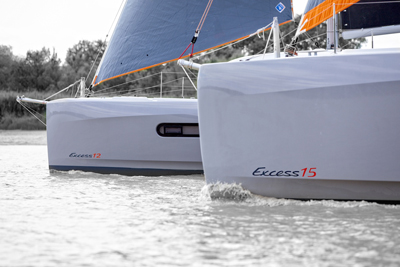 First impressions
First impressions
In harbor, the first thing you’ll notice is the towering mast. The Excess 12 has a bridge clearance of 18.3m (59ft 11in), while the Excess 15’s masthead is 27.9m (91ft 6in) above the waterline. And that’s just the standard rig. The sporty Pulse Line option adds another metre or two.
At sea, Excess cats make a striking impression. Viewed from afar, the lofty rig cuts the horizon like a shark’s dorsal fin. At closer range you’ll notice the distinctive styling (by Patrick le Quémant, a legend in the world of automotive design who recently started drawing yachts including Lagoons, Outremers and Gunboats).
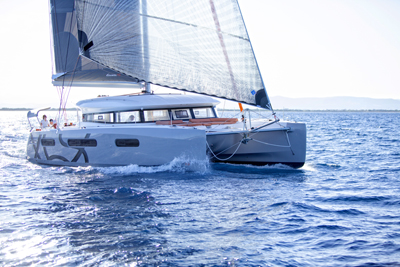
Off the wind, when you fly a code sail the helm – and indeed the whole boat – comes alive.
Stepping aboard via a sidedeck or the inside aft quarter of one of the hulls, which are cleverly designed to function as dinghy docks, you’ll note the excellent ergonomics – secure handholds seem to fall naturally to hand – and then the enormous expanse of cockpit. As you take the helm or choose a seat, you’ll notice the near perfect sight lines. The view through the bridgedeck is so clear you could almost forget it’s there.
Design and construction
The design brief was to create a range of yachts aimed at keen, experienced sailors and restore the sensations that monohull owners often miss when they sail a cruising cat. The platform to hull length ratio is short – usually an indicator of good performance and seakeeping – and there’s plenty of volume in the bow sections to damp the pitching motion. The hulls have a high load-carrying capacity, which is a bonus for blue water cruising. They have fixed keels rather than daggerboards, which does widen their tacking angle but reduces the risk of breakages and makes them easier to sail.
Regular resins, fibers and core materials are used rather than high-cost carbon composites but vacuum infusion keeps the weight down. More weight and cost savings are achieved by simplifying the furniture – open lockers rather than chests of drawers, for example – and by building it as integrated modules.
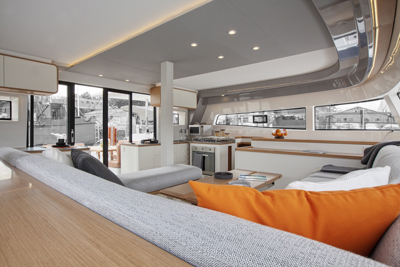 This is the comparable salon view aboard the Excess 15 looking aft to the galley and cockpit.
This is the comparable salon view aboard the Excess 15 looking aft to the galley and cockpit.
In the cockpit
The cockpit layouts are excellent. These boats are as easy to sail singlehanded as any other cruising multihull, yet they also reward active participation by the rest of the crew: three or four keen sailors can have fun working the boat without getting in each other’s way. Large rope bins next to the primary winches stop the cockpit sole from turning into a snakes’ wedding.
The huge convertible roof (also used on Beneteau Sense monohulls) has a transformative effect on the cockpit. There’s a great view of the sails from the two helm stations even when it’s shut, but the open roof gives an equally clear view for the rest of the crew.
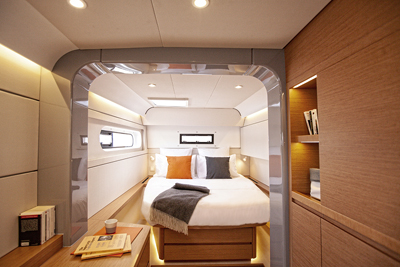 The cabin shows the elegant modern finish and convenient touches like drawers below the berths.
The cabin shows the elegant modern finish and convenient touches like drawers below the berths.
On deck
Three wide, moulded steps take you up onto the sidedecks. The titanium-coated stanchions and mooring cleats are a nice touch and all of the sail-handling hardware is high-quality kit. There’s no forward cockpit on either model, which saves on weight, but there’s a large, cushioned sunpad on the Excess 15’s foredeck.
Up at the bows there’s an alloy crossbeam braced by a slender longeron that serves as a conduit for the anchor chain, leading forward from a windlass and locker in the front of the bridgedeck to a bow roller that can hold a wide range of anchor types.
Both yachts have a long bowsprit for crossover sails and gennakers, supported by twin martingales anchored to the hulls just above the waterline. A crossover sail can stay securely locked on its furler while the self-tacking jib is in use.
Rig and sailplan
The Excess cats’ masts are much further aft than you might expect. This is a recent innovation with proven merits – it reduces pitching and allows for a more balanced sailplan with a decent-sized headsail rather than requiring a tiny jib.
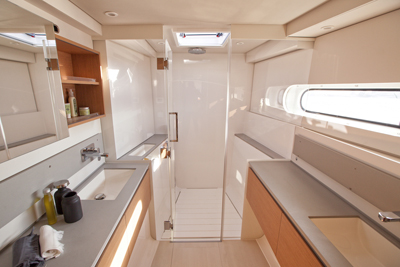 The head is delightfully bright and spacious.
The head is delightfully bright and spacious.
On both models, rig geometry is relatively simple for a multihull: a fixed (non-rotating) mast with 9/10 fractional standing rigging, B&R-style swept-back cap shrouds instead of a backstay and lower/intermediate diamond shrouds (including jumpers) on one or two sets of in-line spreaders.
Both boats have an ultra-high aspect, square-top mainsail to take full advantage of the faster, less turbulent airflow up at the masthead, and a large self-tacking jib that sheets to a track on the cabin top. There’s no vang or kicker. Instead, the Excess 12 has a triangulated mainsheet bridle with a powerful multi-block purchase and an electric winch; the Excess 15 has an extra-long mainsheet traveler driven by a captive line reeler. Both of these give all the control you need for cruising. For racing, you can rig up a flying barber-hauler.
The Pulse rig option improves both models’ sail area; displacement ratios by a further 10 per cent. Two sets of reefing points is standard but you can have three; with a Pulse Line rig the first reef goes into the mainsail at around 18-20 knots true. Off the wind, a lot more power is available with a furling crossover sail and for downwind legs there’s an even larger gennaker.
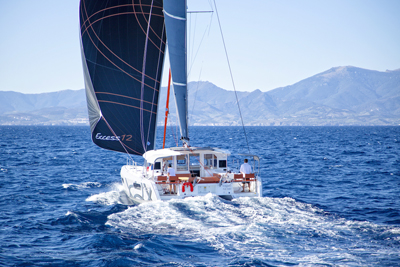 The Excess 12 underway in a fresh breeze.
The Excess 12 underway in a fresh breeze.
Under sail
We had a good sailing breeze of 12-20 knots true and a short, lumpy sea that the Excess cats took in their stride. To complicate our boatspeed readings there was roughly a knot of current.
It takes about 30 seconds to hoist an Excess cat’s mainsail with an electric winch – you can do it manually, but with such high-aspect ratio sails you won’t want to. The twin helms, outboard on the aft ends of the hulls, feel absolutely right with a commanding view of the sea and the sails, all controls within arm’s reach and the rest of the crew close enough for clear communication and convivial conversations. Dyneema steering cables deliver direct, positive feedback between the wheels and rudders.
Close-hauled, the Excess 12 made 5.3 knots over the ground in 13 knots true and 6.4 knots when in 18 knots of breeze. She would have been faster on flat water and without a foul current. A deliberately inept, hesitant tack revealed her to be a well-mannered boat that carries her way nicely. The Excess 15 made 7.1-8.6 knots close-hauled in similar conditions.
 This view of the salon shows the dinette and galley area.
This view of the salon shows the dinette and galley area.
Reaching with a crossover sail, we logged 7-9 knots on the Excess 12 and 9-11 knots on the Excess 15. The helm, indeed whole boat, comes alive with an offwind sail deployed. The numbers might be only a knot faster than a more comfort-oriented cat, but the sailing experience is noticeably different.
Bridgedeck clearance on both models is generous, as it should be. I did eventually get the Excess 15 to slam – only slightly and rather unfairly – by rounding up into a patch of overfalls. To her credit she ploughed on with a few slaps and judders. Others I’ve sailed would have bucked and stalled.
Under power
Both test yachts had engine upgrades. With twin 45hp Yanmars the Excess 12 made 7.5 knots at cruising revs without much noise and 8.1 knots flat out. The Excess 15 cruised comfortably at 8.5 knots and made 10 knots at full throttle with two 80hp engines. Dual throttle controls and bow thrusters made both yachts easy to maneuver in harbor.
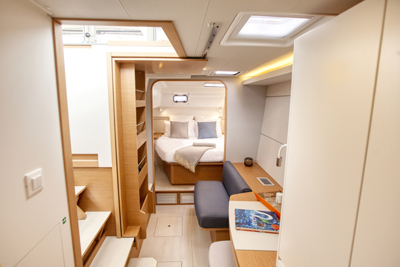 The cabins are inviting and feature open storage and convenient seating areas.
The cabins are inviting and feature open storage and convenient seating areas.
Living aboard
With clear windows rather than tinted glass in the bridgedeck and lots of deck hatches that serve as skylights, it’s impressively bright and airy inside. Three interior design themes cater for different tastes and there are three layout options for each yacht – you can have a hull to yourself or take your whole extended family cruising with up to six double cabins on the Excess 15 or four doubles on the 12. Despite being built to save weight, the furniture has a solid, high-quality feel. A well-equipped galley with domestic-size appliances occupies one corner of the stylish, spacious salon.
Verdict
What difference does ten percent make? Quite a lot – it’s about sensations, not statistics. The Excess 12 and 15 reward and encourage good sail trim, they’re fun to steer and can keep an experienced crew engaged. That said, they’re quite easy to sail and not twitchy, challenging or extreme. For any cruising yacht there’s a fine balance to be struck between exhilaration and relaxation – and Excess seems to have nailed it.
 Dealer: Marina P.A. Gagnon, 982 rue Principale, J0J 1G0 St Paul de l’Île aux Noix (Québec), Canada.
Dealer: Marina P.A. Gagnon, 982 rue Principale, J0J 1G0 St Paul de l’Île aux Noix (Québec), Canada.























